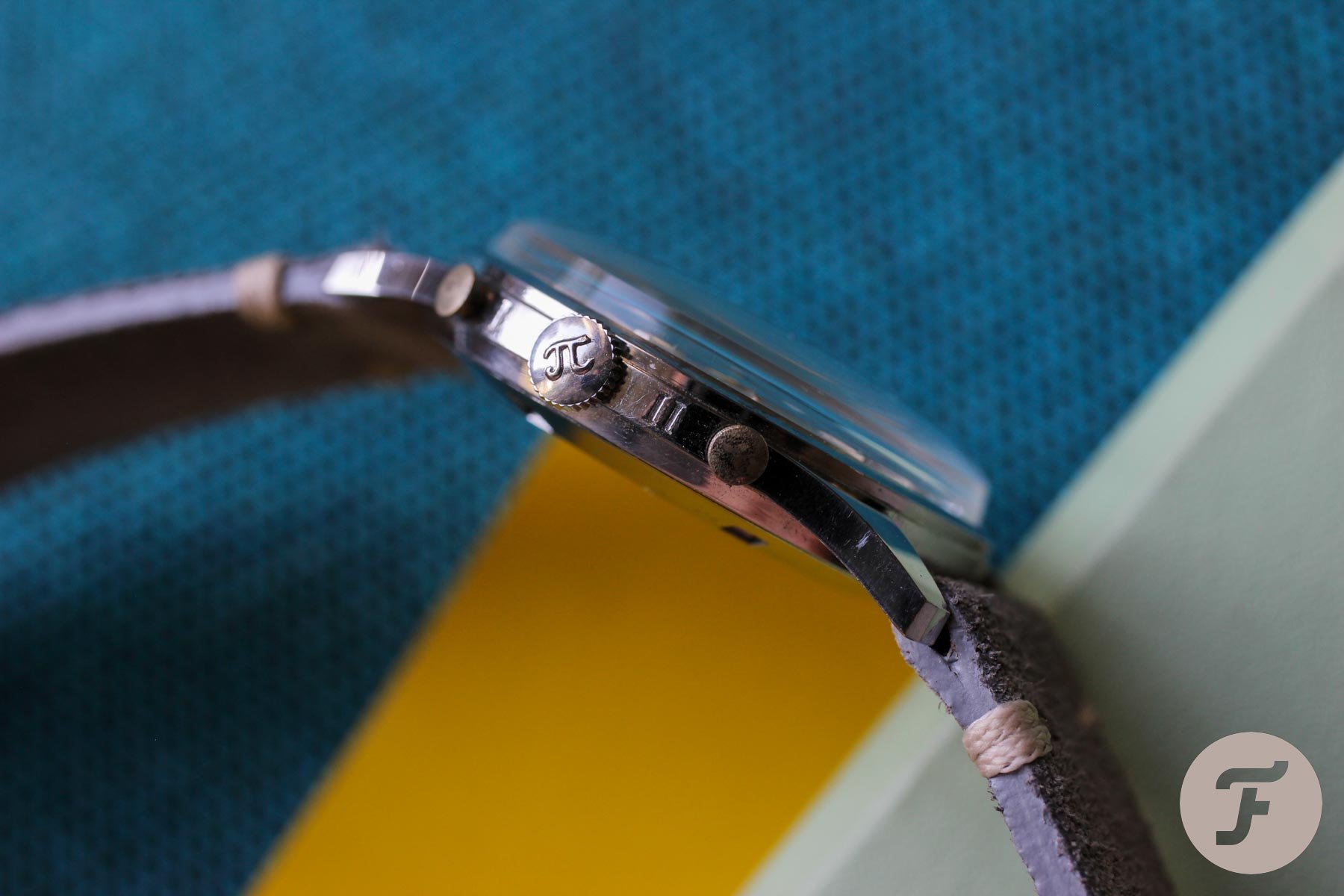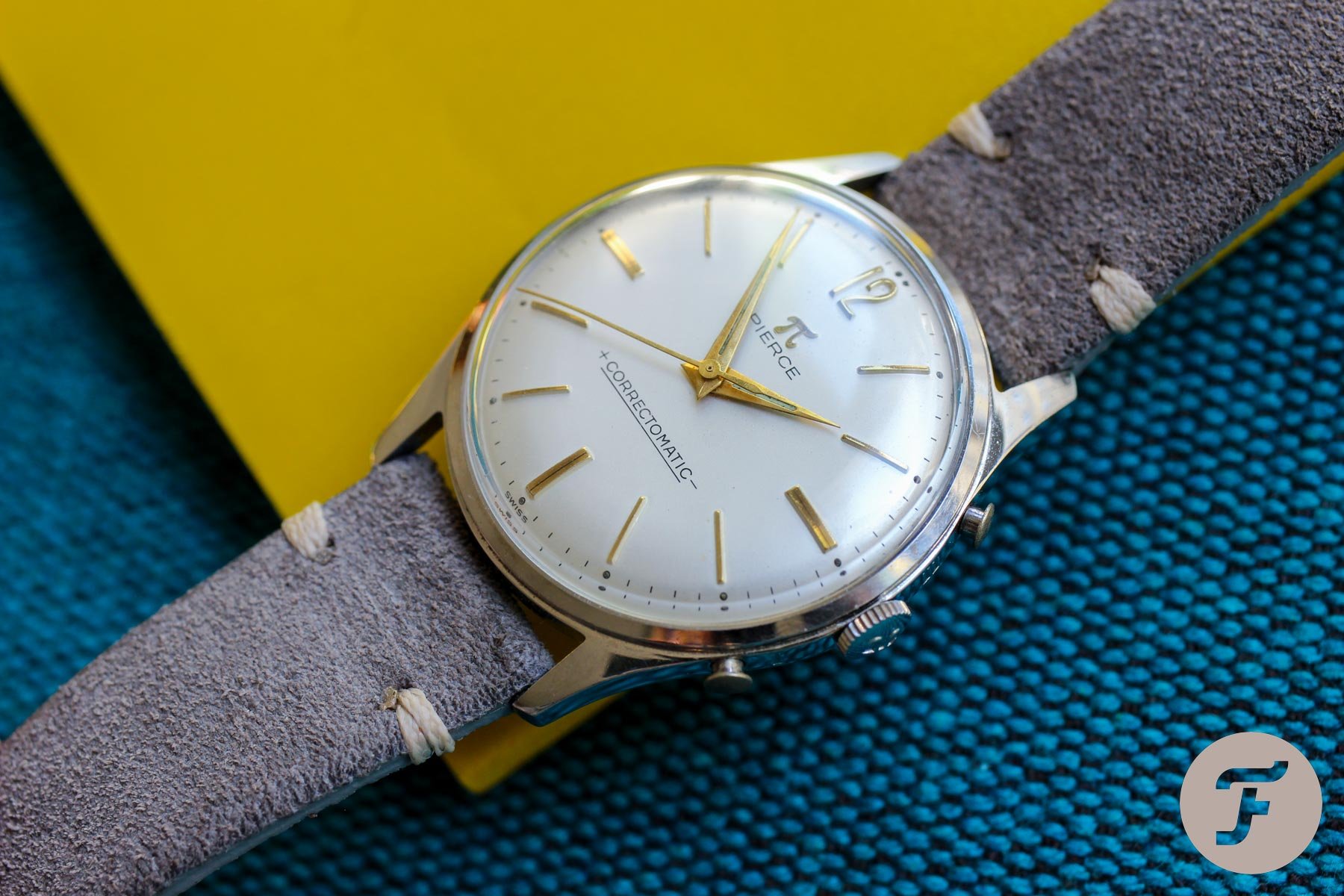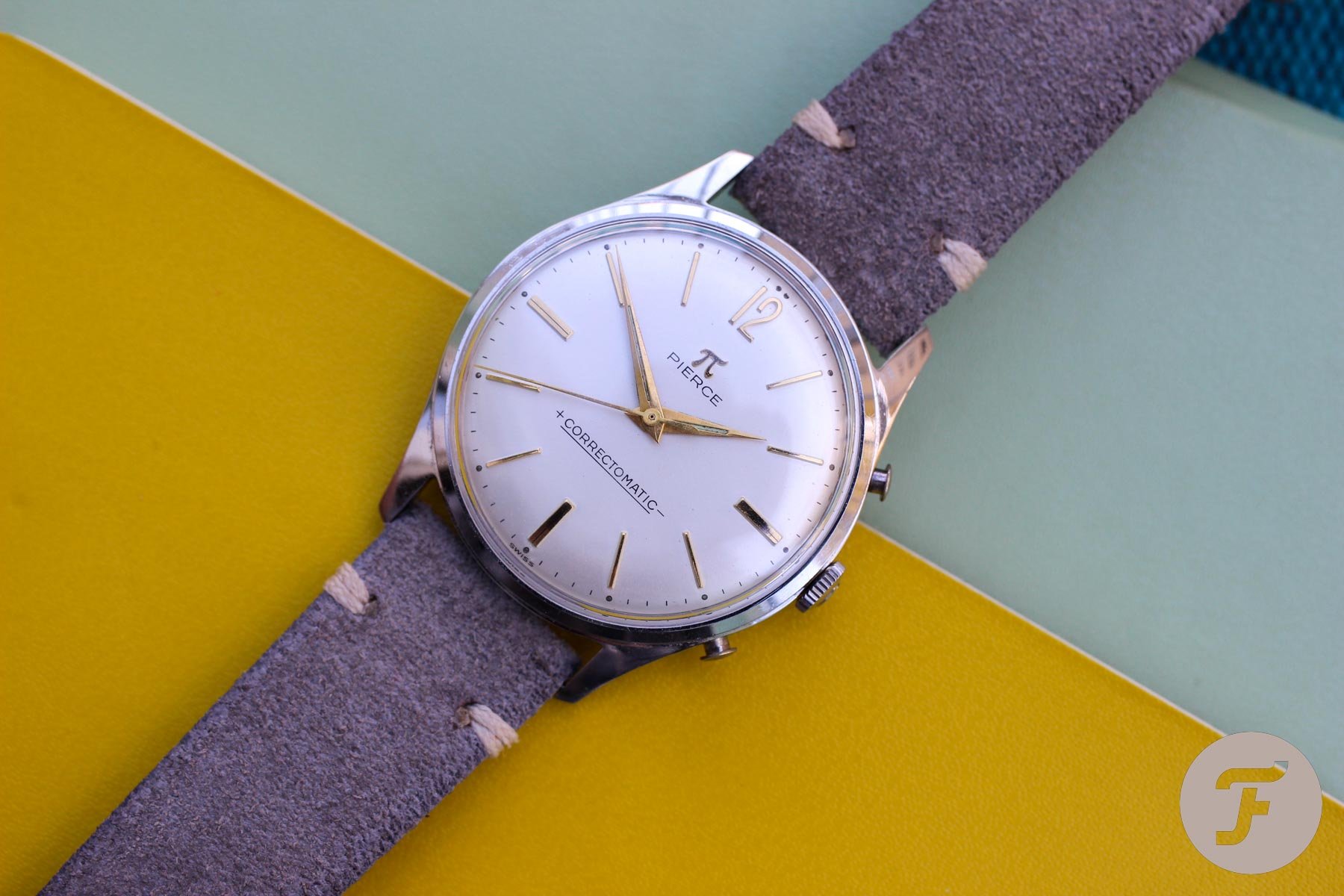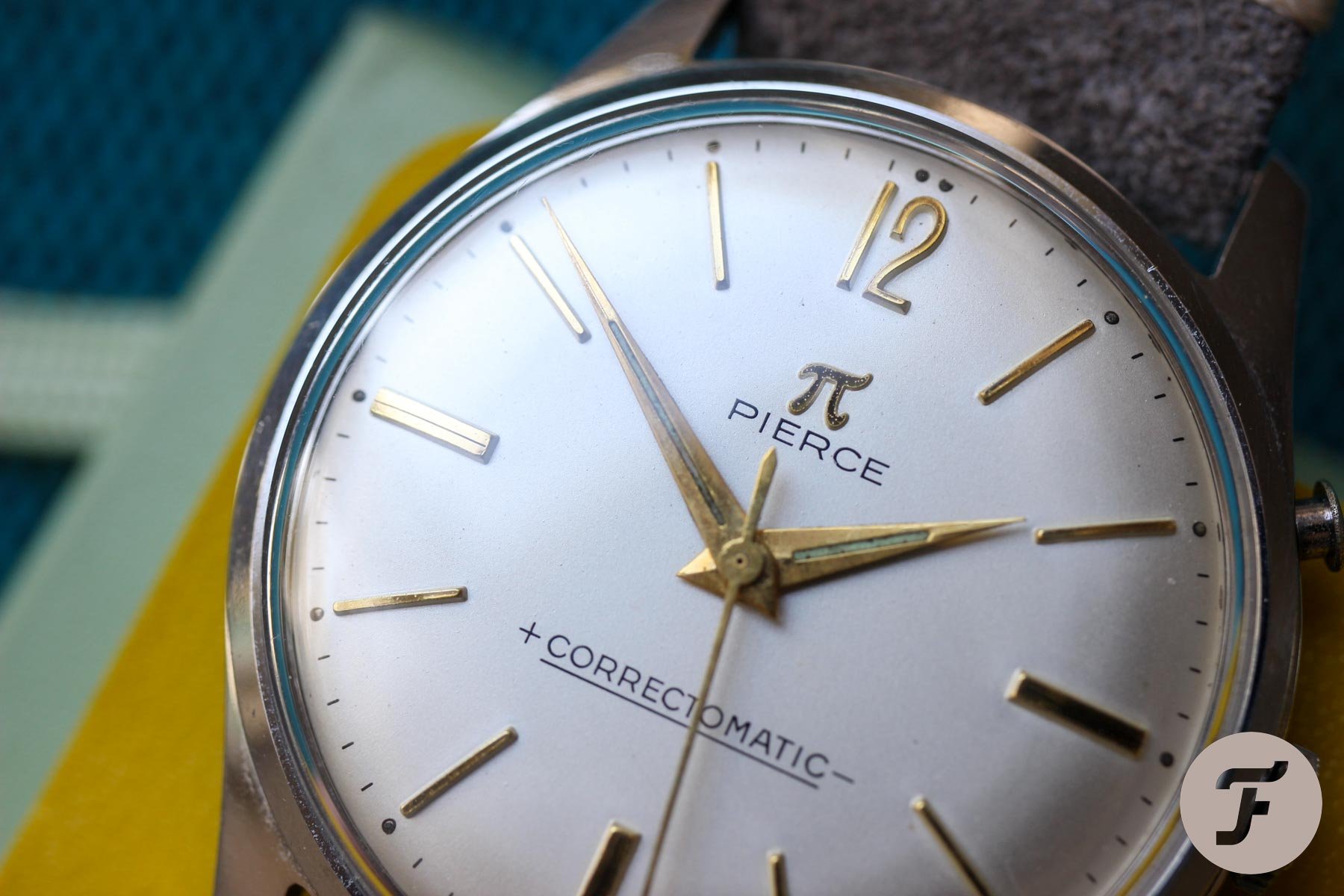#TBT An Utterly Mindblowing Vintage Discovery Pierce Correctomatic
It has pushers, but it’s not a chronograph. What are the flat cap pushers on the Pierce Correctomatic for? I will tell you thanks to my first watch swap ever. If you were to read and remember one single article from this year‘s #TBT series, you are about to read it now!
It all started in July this year with my story The Top Four Weirdest Pushers On Vintage Watches. Or to be more precise, it was only a prelude to the real story that followed thanks to the comments under an article. LooselyWound, one of our readers, asked What about the Pierce Correctomatic, it had pushers that allowed you to adjust the timing of the balance! I knew of a few other external regulation systems, with the crazy Sperina Regulator on top of the list. But I had never heard about the Pierce Correctomatic. And it wouldn’t be me if I didn‘t start to dig deeper…
Decoding the Pierce Correctomatic
All we see are two of the simplest small pushers mounted on a decent dressy three-hander. If you compare them to any typical pushers, these look a bit comical. I guess the designers wanted to keep the elegant and minimalist style. It’s a mystery to me, why they didn’t opt for a pin pusher and chose a cylinder-like style instead. It looks a bit funny, but it is unique and definitely stands out against industry standards. After all, their function is pretty unique too. They should somehow control watch regulation. But how exactly?
Only finding more questions
A +/- symbol on the dial suggests that one pusher moves the regulator in one direction and the second one to the other. This makes the watch run faster or slower. Things get interesting when you find out that pressing both pushers sometimes resets the second and minute hands to the nearest 15minutes. Exactly as the phenomenal and truly rare Mido Radiotime. I did what I usually do. I looked into some books and started to google. The problem is, there isn’t much to study. And if there is, it’s pretty vague. I hit a blind spot.
I tried go the other way, to locate a piece and buy it. As it usually goes with rare specimens, one can hardly find three pieces. That’s about how many Pierce Correctomatic records I found. And usually, they were all sold decades ago or they sat in a collection with no intention of leaving it. Uncovering another layer of the Internet I found one Pierce Correctomatic in a popular thread What are you wearing today? on the German UhrForum.de. In a post from 2019, there it was, a shot of a beautiful, rare steel version in stunning minty condition but with no further explanation.
It was mid-July and we were on vacation in Italy with my wife and kids. In the evening when everyone fell asleep, the Pierce Correctomatic came to my mind, and with nothing better to do, I decided to send the guy a message if he would consider a deal.
Lucky day
Over the years, I have found a watch from my endless list of rarities many times without being able to trace down one single owner. This time I could see the owner’s profile and even send him a message. For the record, I was ready to be shot down instantly. Like I was countless times before when trying to get some other rare gem you can’t buy no matter how much money you put on the table. Owning this kind of watch is not about its financial value, but rather its historic value. I don’t even know why, I offered a trade as well as a purchase. When I checked my mailbox the next day, I could not believe my eyes. Sandy was open to suggestions and asked what I have to offer!

My first watch swap ever
My heart rate exploded and I started to flip through my collection in my mind, trying to figure out what to offer. Well, as I did not find anything, I had to give it a second round. I lined up a spare #TBT Dead Seconds Tourist Radio-Top, a Seiko 6309-7049 Diver, a 1960s Elgin Diver Watch, and a TBT French Yema Navygraf II. Our discussion with Sandy continued at a chilled pace and I had to wait until the next day to learn what needs to be sacrificed.
We sealed a “correct” deal
I thought Sandy might choose dead beat Chézard movement. Well, he would if he didn’t already have one. “I immediately fell in love with the Yema. A real diver watch! The Yema brand has always appealed to me, but until now I do not own any. If you do want to swap, then we would have a swap,” wrote Sandy. And we had a swap.
Now comes the side-story surprise. I kept my wife updated all the way about an exciting swap with Sandy. Obviously, after we struck the deal, I victoriously announced to my wife that we got it. I am not sure if my wife (half-indifferent while sipping her wine and reading her book) put it as a question or just as a statement, but she just said: “is Sandy a woman?”
Well, she is. I felt ashamed, amused, and biased at the same time. To see (or not to literally see in this case) a woman among vintage watch collectors is not so usual. I can tell you I was very happy to get to know her and have since learned more about her. She has an amazing story to tell on when and how she got into vintage watches. Her collection is fascinating and I love every bit of it and the way she builds it. Look forward to the next #TBT, where you’ll find an interview with Sandy and her watch story. Now let’s get back to the Pierce Correctomatic.
Unboxing
I don’t remember if I have ever been more excited. There were watches I was looking for, but the Pierce Correctomatic was the real one shrouded in mystery. I didn’t how exactly it worked. I was quite fascinated by the looks of it. Not only was it in a steel case, but it was in great condition. No deep scratches, no stains on the pearl dial, or gold-plated indexes. The slightly dirty lume didn’t bother me at all. A 35mm case felt sporty right after I strapped it on. On the wrist, the Pierce Correctomatic looks quite modern. According to this source, the Pierce Correctomatic came to the watch world in 1964. So about three decades after its possible role model, the Mido RadioTime.
I think I don‘t need to highlight how cool the “π” symbol looks on the dial. And even more so on the thin crown that I believe is correct and original to the watch. One of the details that caught my attention was the unusual stamping on the Pierce signed case back. I got it after I found the detail of the case back on the gold-plated Pierce Correctomatic example. It’s the same case back, just the word BACK was over-stamped with arrows, to mark my Correctomatic as a full steel watch. That’s one way to do it…
First test
The view on the crown side of the case is just divine. What looks like hand-stamped Roman numerals I and II and sign pushers give the watch a very special feel. The engraving is bigger than necessary and looks like a dull instruction manual. But at the same time, it feels special, unique, almost like a noble engraving. I didn’t know which button to press, so I pressed the upper one (I think). Unless the hands were +/- 3 minutes around the full, quarter, or half an hour mark, nothing happened. If it reset, it reset so-so, not aligning the hands correctly. Educated by my own past mistakes, I let it be and knew what had to come next. To visit my watchmaker with a task to bring it back to its former glory. Whatever glory means this time. But I was sure Tomas would figure it out. And he did.
Resetting explained
My Mido Radiotime needed watch service too, so I left both watches with him. The picture above explains why they reset differently. The heart cam on the left is from the Mido that allows resetting hands anytime to the nearest quarter-hour to 0, 15, 30, or 45. The four-leafed clover cam on the right side from the Pierce Correctomatic allows the counterpart to slide in only at particular times, about three minutes around the nearest quarter-hour. So once you hear a radio time signal or listen to a time announcement, your watch can‘t be faster or slower than 2-3 minutes in comparison to real-time. So where is the advantage compared to the 30 years older Mido Radiotime?
The Pierce Correctomatic also adjusts the watch pace. And it doesn’t apply a simple try and miss approach in comparison to other self-regulating watches where you don’t exactly know how much you adjusted it by. On day one you align the Correctomatic with a radio signal by pressing the lower pusher II. After 24 hours you wait for another radio signal and regardless of whether the watch goes faster or slower within the variance of two to three minutes, you press the upper pusher. And you have to do it precisely, thoroughly, and firmly.
Pushers’ time
The upper pusher is connected not only to the resetting mechanism but also transfers the deviation into a microscopic movement of balance regulation. Depending on whether the watch is faster or slower, the mechanism adjusts the effective length of the balance spring. So not only does it know to move the regulator, but it also knows how much it’s supposed to be moved by. How? The four-leafed clover cam has an almost invisible toothing on the outside edge of the “leaves”. When you press the upper pusher, it does one extra thing the lower pusher can‘t. It activates an extra arm with the wheel that touches the toothed edge of the leaf. This way the four-leafed clover cam sends all three hands to the nearest 15mins interval and in a very delicate way also moves the balance regulator.
Each wrist has a different dynamic matching the lifestyle, activities, or occupations of us humans. So does a watch that runs differently under various angles. And that’s the challenge Pierce Correctomatic decided to solve. After only a few days you could easily set your watch all by yourself to beat in line with your heart.
A weak spot
As we mentioned before, you can reset the hands only within a +/- 3-minute tolerance to the nearest quarter. With the Mido Radiotime, you can do it at any time, without worrying about damaging the movement. But if you press the upper pusher outside of the designated three minutes slots too strongly, you can bend or otherwise damage the adjusting components. Well, that might be the killer point for this watch. You can hardly explain not to press the pusher anytime they want to to the mass market, right? I guess here a limited protection system making it dysfunctional and the perfect excuse for calling for the wrong usage wouldn’t help adoption either. But if operated carefully, the concept sounds brilliant. Does it actually work in real life though?
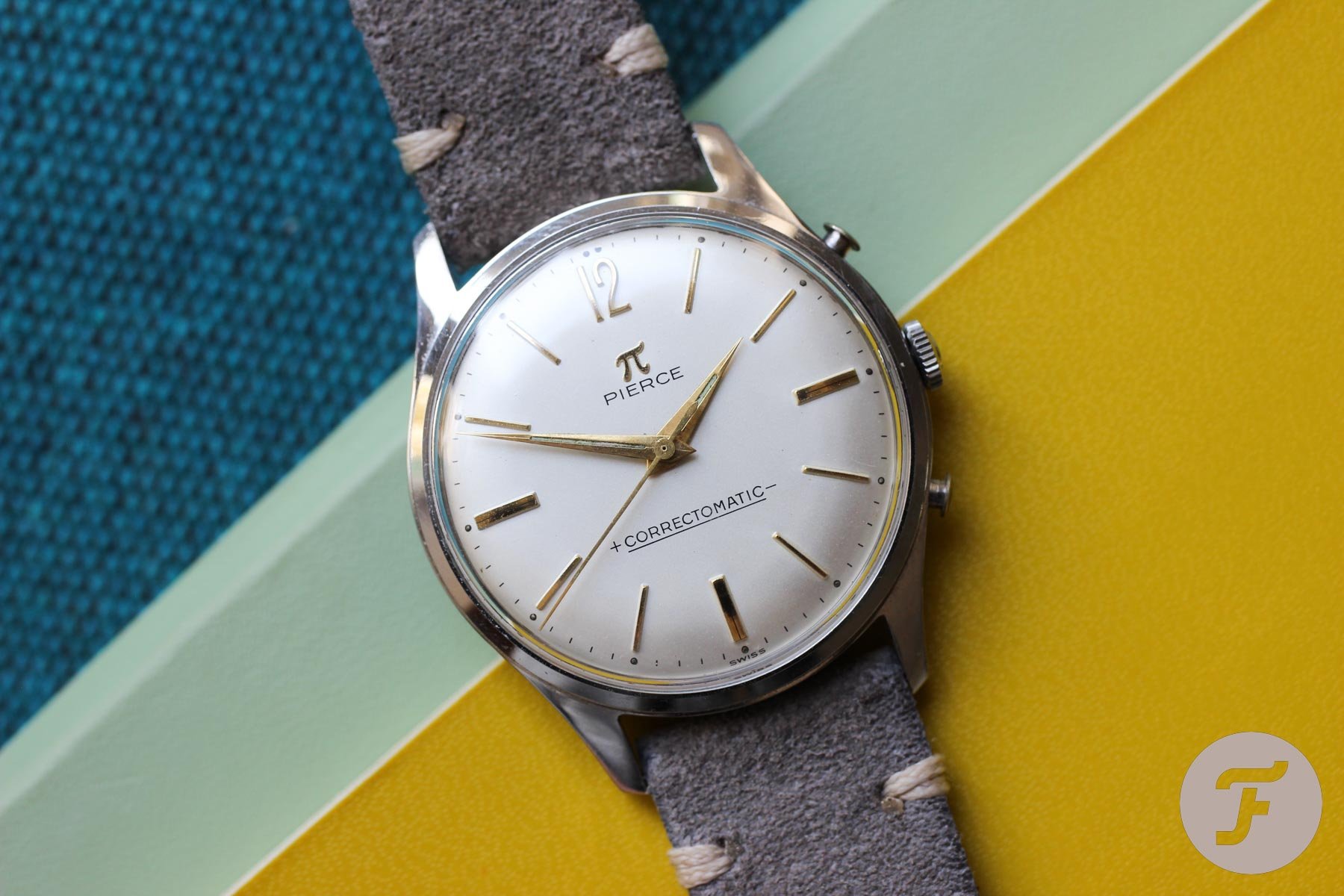
Correctomatic in its first live test
I conducted my first test under controlled conditions with Pierce Correctomatic sitting on the table in the same position, so I could eliminate potential inaccuracy due to changing watch positions during the day. On Sunday at 4 pm I aligned the hands with the time signal using the bottom pusher. After 24 hours I checked the Correctomatic against the correct time and the Twixt app and it showed it was running 18.3 seconds late. On Tuesday I checked it out again to see if the magic worked. And it had, as the movement delay was only 2.8 seconds. The Correctomatic seemed to be working in a controlled environment, so I went on to live-test it on the wrist and the results were satisfying enough. The Pierce Correctomatic actually works!
Last thoughts
Why had I never heard of this watch before? How many pieces were produced? Was it a success or more probably another experiment that never caught on? There are still a lot of questions hanging in the air. I haven’t succeeded in finding any shots of the original packaging, manuals, leaflets, catalogs, or watch adverts. If you can provide any materials, please, let us know. For the time being, I can tell you that I consider the Pierce Correctomatic one of the most inspirational, interesting, and fascinating watches I have seen thus far. Happy hunting
And a big thank you to Sandy for deciding to part with your precious piece.







